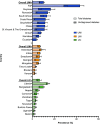Diabetes Prevalence and Its Relationship With Education, Wealth, and BMI in 29 Low- and Middle-Income Countries
- PMID: 32051243
- PMCID: PMC7085810
- DOI: 10.2337/dc19-1782
Diabetes Prevalence and Its Relationship With Education, Wealth, and BMI in 29 Low- and Middle-Income Countries
Abstract
Objective: Diabetes is a rapidly growing health problem in low- and middle-income countries (LMICs), but empirical data on its prevalence and relationship to socioeconomic status are scarce. We estimated diabetes prevalence and the subset with undiagnosed diabetes in 29 LMICs and evaluated the relationship of education, household wealth, and BMI with diabetes risk.
Research design and methods: We pooled individual-level data from 29 nationally representative surveys conducted between 2008 and 2016, totaling 588,574 participants aged ≥25 years. Diabetes prevalence and the subset with undiagnosed diabetes was calculated overall and by country, World Bank income group (WBIG), and geographic region. Multivariable Poisson regression models were used to estimate relative risk (RR).
Results: Overall, prevalence of diabetes in 29 LMICs was 7.5% (95% CI 7.1-8.0) and of undiagnosed diabetes 4.9% (4.6-5.3). Diabetes prevalence increased with increasing WBIG: countries with low-income economies (LICs) 6.7% (5.5-8.1), lower-middle-income economies (LMIs) 7.1% (6.6-7.6), and upper-middle-income economies (UMIs) 8.2% (7.5-9.0). Compared with no formal education, greater educational attainment was associated with an increased risk of diabetes across WBIGs, after adjusting for BMI (LICs RR 1.47 [95% CI 1.22-1.78], LMIs 1.14 [1.06-1.23], and UMIs 1.28 [1.02-1.61]).
Conclusions: Among 29 LMICs, diabetes prevalence was substantial and increased with increasing WBIG. In contrast to the association seen in high-income countries, diabetes risk was highest among those with greater educational attainment, independent of BMI. LMICs included in this analysis may be at an advanced stage in the nutrition transition but with no reversal in the socioeconomic gradient of diabetes risk.
© 2020 by the American Diabetes Association.
Figures

References
-
- International Diabetes Federation IDF Diabetes Atlas, 9th edition [Internet], 2019. Available from https://diabetesatlas.org/en/. Accessed 18 November 2019
-
- Davies J, Yudkin JS, Atun R. Liberating data: the crucial weapon in the fight against NCDs. Lancet Diabetes Endocrinol 2016;4:197–198 - PubMed
-
- Boerma T, Victora C, Abouzahr C. Monitoring country progress and achievements by making global predictions: is the tail wagging the dog? Lancet 2018;392:607–609 - PubMed
Publication types
MeSH terms
Grants and funding
LinkOut - more resources
Full Text Sources
Medical

